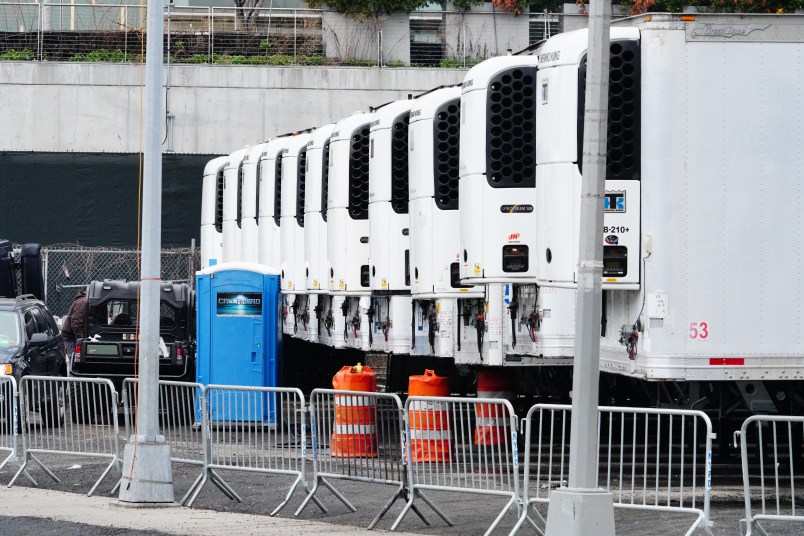There’s still so much we don’t know.
As health care systems in New York City and around the country start to buckle under the stress of COVID-19 patients, it’s not clear what the true death toll of the pandemic will be.
The question goes beyond those who are dying directly from COVID-19, the disease caused by the virus. The Trump administration’s optimistic estimates now project the range from direct deaths at 100,000 to 240,000.
But will we know the toll from the entire crisis?
The untold stories of people who don’t go to see overburdened doctors, delaying treatment for illnesses that turn terminal, or of those who languish as they wait for treatment at emergency rooms flooded with COVID-19 patients suggest that more people may die from the stress that the flood of patients places on the health care system.
Meanwhile, the lack of testing has meant that people may have died of COVID-19 itself without ever having been diagnosed. Others may have died before it was clear that the virus was spreading locally throughout the U.S., while yet more may have passed away with atypical symptoms.
Approximations of the true toll are knowable, however, and it’s been done before.
Researchers gained experience in the science of estimating what’s known as excess mortality – deaths that would not have occurred but for some cataclysmic event – after Hurricane Maria devastated Puerto Rico and left the island’s infrastructure and health care system in shambles.
The results of the studies found that thousands of people died in Puerto Rico because of secondary effects from Hurricane Maria. That is to say, these deaths did not occur due to drowning or other causes directly associated with the storm. Rather, these people were hypothesized to have passed away due to lack of health care following the hurricane, said Cruz Nazario, an epidemiologist at the University of Puerto Rico.
Post-storm studies found that significantly more people died as an indirect result of the hurricane than the 64 people included in the official death toll. By the same token, people who died while never having been diagnosed with COVID-19 could be included in similar future studies.
The hurricane makes a particularly good comparison to COVID-19, Nazario argued, because it fundamentally damaged the island’s health care system and infrastructure, leading to questions over how many people died in the months that followed when access to care was limited.
Nazario worked on a study that joined with George Washington University’s Milken School of Public Health to analyze excess deaths that occurred after Hurricane Maria.
“The question that we posed was, ‘would these people have died if the hurricane had not come to Puerto Rico?” she said. “And our main hypothesis was that these deaths would probably have not occurred if not for Hurricane Maria, but if our health system had been strong, adequate, and prepared, it would have been different.”
Nazario told TPM that investigators faced hurdles in part because the government supplied a death count that many refused to believe. U.S. officials placed the official death toll from the hurricane at 64 people, a number many said was contradicted by the reality around them.
“Everybody was commenting that there were so many deaths around them that it was not possible that they were all natural deaths, or deaths due to the underlying conditions that people have,” Nazario said.
The resulting report estimated that 2,975 Puerto Ricans died following Hurricane Maria who would otherwise have survived in the four months following the disaster.
The number jibes with other estimates.
Wolfgang Rolke, a statistician at the University of Puerto Rico-Mayaguez, ran a study that looked at deaths after Hurricane Maria which found that 822 excess deaths occurred over the six-week period following the hurricane.
That study was designed to capture excess deaths that occurred close to the actual hurricane, but weren’t included in the initial death toll of 64.
Rolke told TPM that monthly mortality data leading up to the hurricane allowed researchers to establish a benchmark, based on government figures. From there, it was possible to compare the benchmark to time after Maria.
Massive amounts of people fleeing Puerto Rico after the hurricane complicated the study. It became less clear what the actual population of the island was, changing the mortality rate and forcing researchers to recalibrate their projections.
That specific problem wouldn’t affect a COVID analysis, Rolke said, given that it’s a global crisis. But similar variables like a drop in car accident deaths due to social distancing policies could affect the outcome.
Nazario said that the GW report took historical death data to generate a projection of how many would have been expected to die in Puerto Rico under normal circumstances. That included looking at average mortality by certain age and gender groups.
If a given age group had a fatality rate of 10 per 10,000 people, and that rate jumped to 20 per 10,000 in the months after the hurricane, the researchers would then hypothesize that “the deaths that occurred above the expected average were indirectly associated with Hurricane Maria,” Nazario said.
The same method could be adapted to COVID-19, the researchers said, offering an estimate of what the overall spike in deaths might be.
That total would encompass deaths due to a sagging health care system, but also COVID-19 deaths that may have gone undetected. Looking at mortality rates starting in January and February – when spread of the illness in the U.S. is hypothesized to have begun but before widespread testing – could reveal early spikes in death and clusters of the disease.
“I keep comparing what we’re facing with Hurricane Maria,” Nazario said. “We were not prepared for the hurricane.”
Tierney Sneed contributed to this report.






